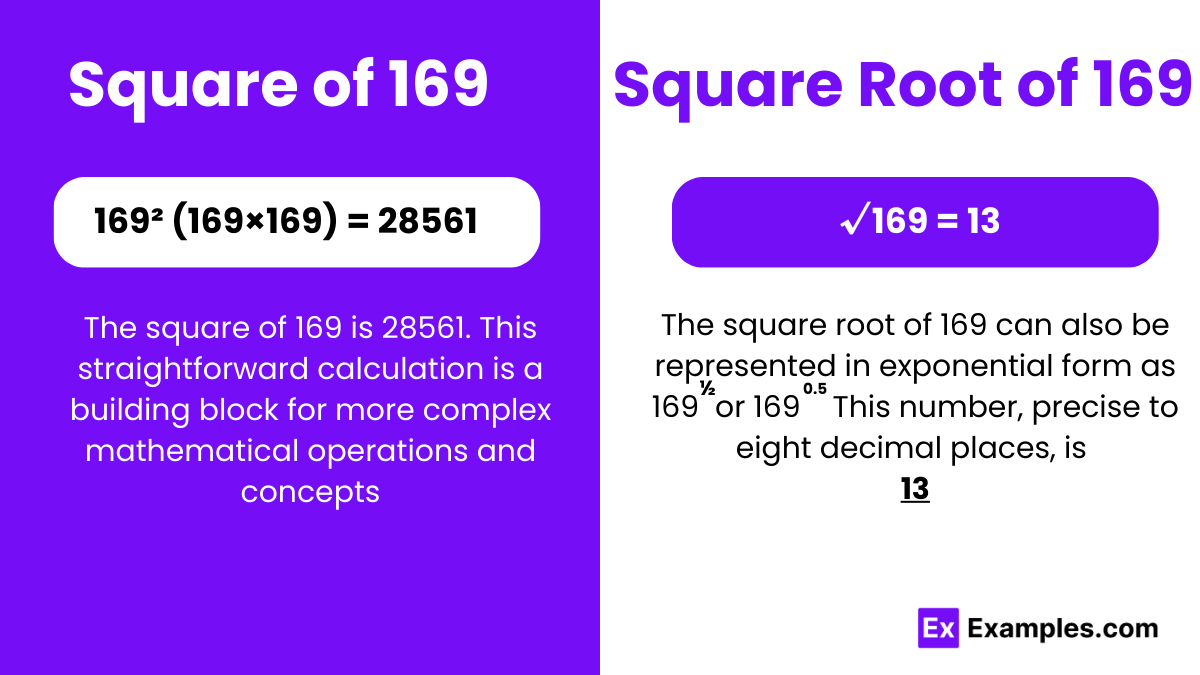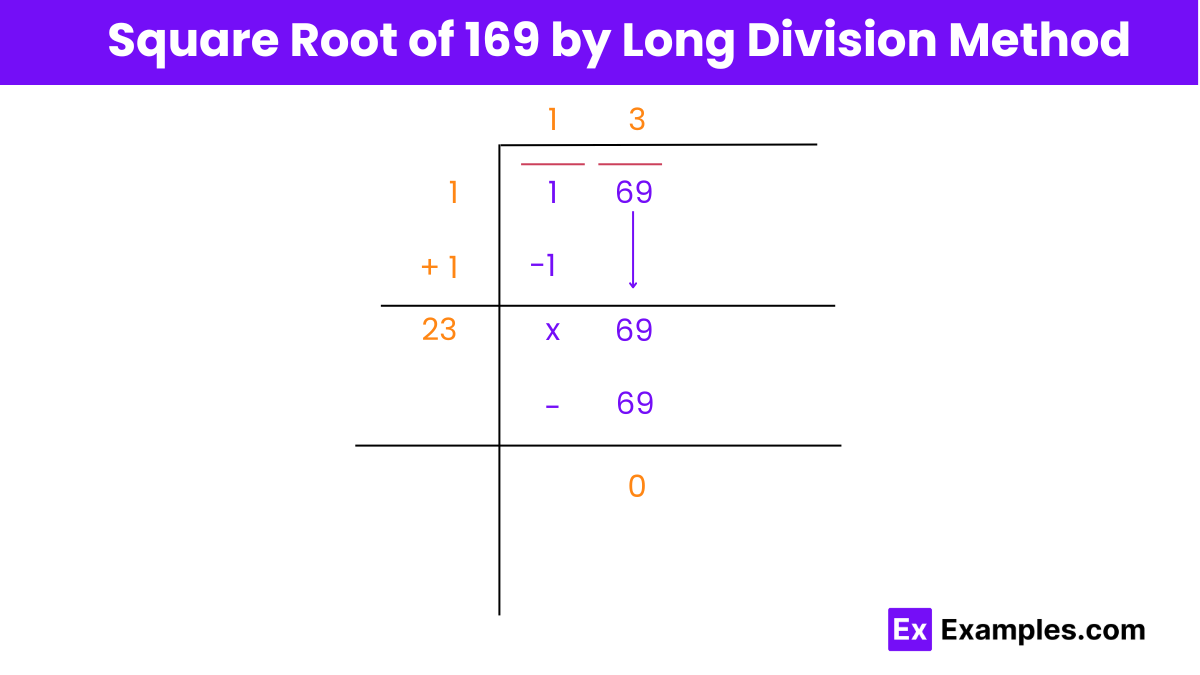What is the square of 169?
289
324
361
400

The square of 169 (169²) is calculated by multiplying 169 by itself:
169 × 169 = 28561.
So, the square of 169 is 28,561.
Geometrically, if you have a square numbers with each side measuring 169 units, the total area enclosed by the square will be 28,561 square units.
Understanding the square of 169 is essential in various mathematical contexts, including geometry, algebra, and arithmetic. It finds applications in calculating areas, volumes, distances, and solving mathematical problems.
This is because 13 × 13 = 169.
Thus, the square root of 169 is exactly 13. This calculation is important in various mathematical and practical contexts, such as geometry, where it can represent the side length of a square with an area of 169 square units. It’s also significant in algebra and engineering, where understanding square roots helps in solving problems involving areas and other applications that require precise measurements.
Square Root of 169: 13
Exponential Form: 169^½ or 169^0.5
Radical Form: √169
The square root of 169 is rational number because it equals 13, a whole number. Rational numbers include all integers, fractions, and decimals that can end or repeat. Since 13 is a clear, whole number, it’s definitely rational.
Prime Factorization
Prime factorization involves breaking down a number into its prime factors. Since 169 is a product of the prime number 13 (169 = 13²), the square root is easily recognized as 13.
Using a Calculator
The simplest and most accurate way to find the square root of any number, including 169, is by using a calculator. Simply entering “√169” will provide the precise answer, which is 13.
Long Division Method
This traditional method involves a step-by-step process similar to long division. It’s particularly useful for finding square roots of larger numbers but can be applied to smaller numbers like 169 as well:
Guess and Check Method
Start by guessing a number that, when squared, comes close to 169. Test different numbers if necessary. Since 12² = 144 and 14² = 196, you can deduce that the square root of 169 is between 12 and 14. Fine-tuning your guess to 13 will show that 13² equals 169.
These methods provide various ways to determine the square root of 169, whether you prefer a mathematical, technological, or visual approach.

To find the square root of 169 using the long division method, you can follow these steps:
Step 1: Set Up the Number:
Write 169 and take the digits in pairs from the right. In this case, 69 is taken as one pair and 1 stands alone.
Step 2: Initial Division:
Divide the leftmost number by a digit such that when multiplied by itself gives a product equal to or less than that number. Here, 1 divided by 1 gives a quotient of 1 and a remainder of 0.
Step 3: Bring Down Next Pair:
Bring down the next pair of digits, which is 69, for the next part of the division.
Step 4 : Adjust the Quotient:
Multiply the current quotient (which is 1) by 2, giving 2. Append a digit (let’s call it X) to this number to form a new divisor. This new divisor will be 20X.
Step 5: Find the Correct Digit:
Find a digit X that, when added to 20 and then multiplied by X, gives a product less than or equal to 69. The correct X in this scenario is 3 because when you add 3 to 20, giving 23, and multiply 23 by 3, the product is exactly 69.
Step 6: Update Quotient and Remainder:
The new digit 3 is added to the quotient, making the updated quotient 13. The remainder after subtracting 69 from 69 is 0.
Thus, using the long division method, the square root of 169 is found to be 13, with a remainder of 0, indicating a perfect square.
It has a square root of 13, which is a whole number. This means that when you multiply 13 by itself (13 × 13), you get 169. The property of having a whole number as a square root defines it as a perfect square.
Yes, the square root of 169 is a natural number. It is 13, which is a positive integer and falls within the set of natural numbers.
The number closest to the square root of 169 is 13 itself, as it is the exact square root. The nearest integers are 12 and 14.
Text prompt
Add Tone
10 Examples of Public speaking
20 Examples of Gas lighting
What is the square of 169?
289
324
361
400
What is the square root of 169?
11
12
13
14
Which of the following numbers is closest to the square root of 169?
12
13
14
15
Which of the following equations is correct?
\sqrt{169} = 12
\sqrt{169} = 13
\sqrt{169} = 14
\sqrt{169} = 15
If x = \sqrt{169} , what is x2=?
169
338
196
144
What is the simplified radical form of \sqrt{169} ?
12
13
14
15
What is the value of \sqrt{169} + \sqrt{25} ?
17
18
19
20
Which pair of numbers is such that their product is 169 and their sum is 26?
13 and 13
14 and 12
15 and 11
16 and 10
If the area of a square is 169 square units, what is the length of each side of the square?
10 units
12 units
13 units
14 units
If x=13, which of the following expressions is equal to x2?
13+13
13×13
132−1
133
Before you leave, take our quick quiz to enhance your learning!

